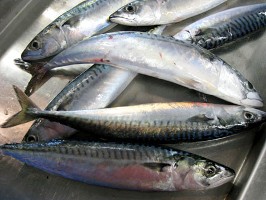Scientists from the National Oceanic and Atmospheric Administration (NOAA) have found warming temperatures of the U.S. continental shelf have changed distribution patterns of Atlantic mackerel, a species found in waters from Cape Hatteras to Newfoundland. The team from NOAA’s Northeast Fisheries Science Center published its findings in the journal Marine and Coastal Fisheries: Dynamics, Management and Ecosystem Science.
The researchers reviewed annual changes in the winter and early-spring distribution of the Atlantic mackerel stock on the northeast U.S. continental shelf using spatial and standard statistical analyses of data collected on research trawl surveys.
Atlantic mackerel migrate great distances on a seasonal basis to feed and spawn, and are sensitive to changes in water temperature, and prefer water above 5 degrees Celsius (41 degrees Fahrenheit). The NOAA scientists found that from 1968 to 2008, the distribution of Atlantic mackerel stock has shifted about 250 kilometers (155 miles) to the north and east. The depth distribution of the stock has also changed, from deeper off-shelf locations to shallower on-shelf ones.
The researchers say that the environmentally-driven shift in distribution patterns will probably make it more difficult to find and catch Atlantic mackerel in certain areas in the future. They note that the Canadian coastal commercial fishery has continued to thrive while the U.S. commercial mackerel fishery during the winter has declined in recent decades.
The change in distribution pattern could also impact other species, since mackerel plays a central role in the ocean’s food ecosystem. Atlantic mackerel are prey for a wide variety of species, while they eat mostly small crustaceans and plankton.
Atlantic mackerel is not a leading fish choice by American consumers, but is more popular in foreign countries. Some of the U.S. harvest is sold fresh but most is frozen and exported to markets throughout the world.
Read more: Community Management Can Sustain Small Fisheries
* * *


 RSS - Posts
RSS - Posts
[…] Environmental Issues Changing Atlantic Mackerel Distribution […]